Ethics and Law for Healthcare Professionals
VerifiedAdded on 2021/04/17
|12
|2626
|196
AI Summary
This assignment delves into the complex relationship between ethics and law in the context of healthcare. It covers various topics such as the right to know the truth for patients, ethical considerations surrounding euthanasia, artificial insemination, sterilization, and the importance of adhering to professional standards. The document draws from a range of sources including academic journals, legislation, and expert opinions to provide a comprehensive overview of this critical area.
Contribute Materials
Your contribution can guide someone’s learning journey. Share your
documents today.
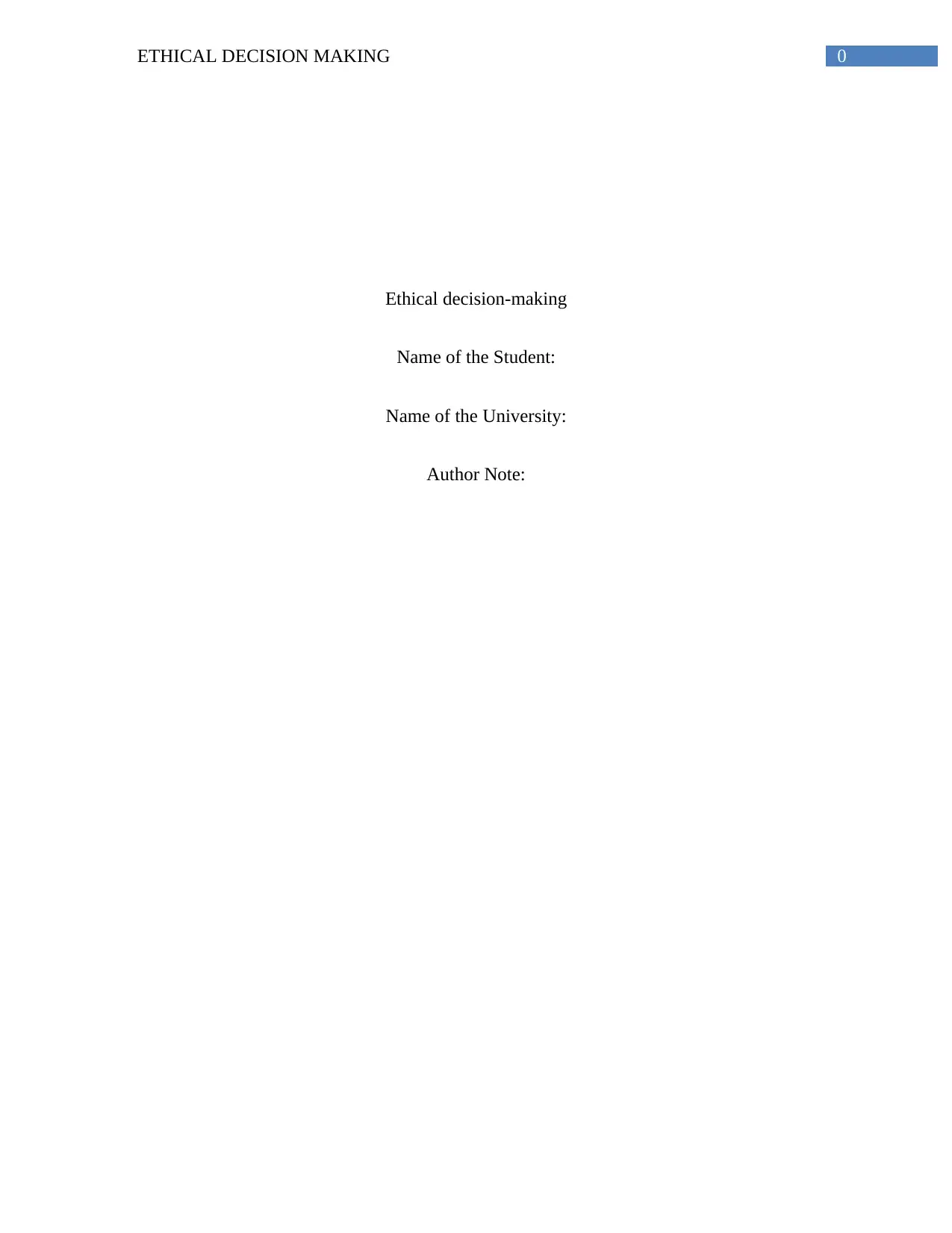
0ETHICAL DECISION MAKING
Ethical decision-making
Name of the Student:
Name of the University:
Author Note:
Ethical decision-making
Name of the Student:
Name of the University:
Author Note:
Secure Best Marks with AI Grader
Need help grading? Try our AI Grader for instant feedback on your assignments.
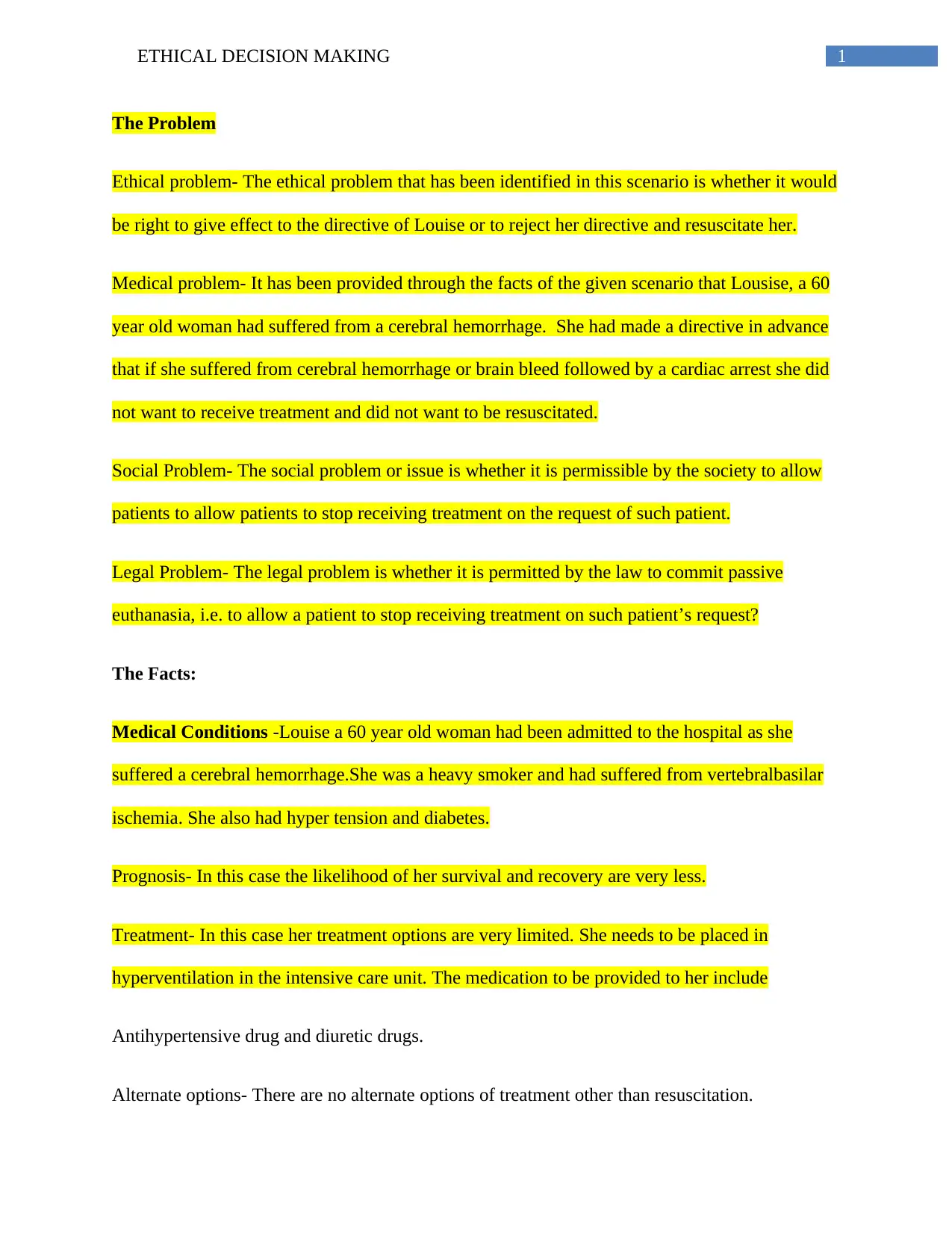
1ETHICAL DECISION MAKING
The Problem
Ethical problem- The ethical problem that has been identified in this scenario is whether it would
be right to give effect to the directive of Louise or to reject her directive and resuscitate her.
Medical problem- It has been provided through the facts of the given scenario that Lousise, a 60
year old woman had suffered from a cerebral hemorrhage. She had made a directive in advance
that if she suffered from cerebral hemorrhage or brain bleed followed by a cardiac arrest she did
not want to receive treatment and did not want to be resuscitated.
Social Problem- The social problem or issue is whether it is permissible by the society to allow
patients to allow patients to stop receiving treatment on the request of such patient.
Legal Problem- The legal problem is whether it is permitted by the law to commit passive
euthanasia, i.e. to allow a patient to stop receiving treatment on such patient’s request?
The Facts:
Medical Conditions -Louise a 60 year old woman had been admitted to the hospital as she
suffered a cerebral hemorrhage.She was a heavy smoker and had suffered from vertebralbasilar
ischemia. She also had hyper tension and diabetes.
Prognosis- In this case the likelihood of her survival and recovery are very less.
Treatment- In this case her treatment options are very limited. She needs to be placed in
hyperventilation in the intensive care unit. The medication to be provided to her include
Antihypertensive drug and diuretic drugs.
Alternate options- There are no alternate options of treatment other than resuscitation.
The Problem
Ethical problem- The ethical problem that has been identified in this scenario is whether it would
be right to give effect to the directive of Louise or to reject her directive and resuscitate her.
Medical problem- It has been provided through the facts of the given scenario that Lousise, a 60
year old woman had suffered from a cerebral hemorrhage. She had made a directive in advance
that if she suffered from cerebral hemorrhage or brain bleed followed by a cardiac arrest she did
not want to receive treatment and did not want to be resuscitated.
Social Problem- The social problem or issue is whether it is permissible by the society to allow
patients to allow patients to stop receiving treatment on the request of such patient.
Legal Problem- The legal problem is whether it is permitted by the law to commit passive
euthanasia, i.e. to allow a patient to stop receiving treatment on such patient’s request?
The Facts:
Medical Conditions -Louise a 60 year old woman had been admitted to the hospital as she
suffered a cerebral hemorrhage.She was a heavy smoker and had suffered from vertebralbasilar
ischemia. She also had hyper tension and diabetes.
Prognosis- In this case the likelihood of her survival and recovery are very less.
Treatment- In this case her treatment options are very limited. She needs to be placed in
hyperventilation in the intensive care unit. The medication to be provided to her include
Antihypertensive drug and diuretic drugs.
Alternate options- There are no alternate options of treatment other than resuscitation.
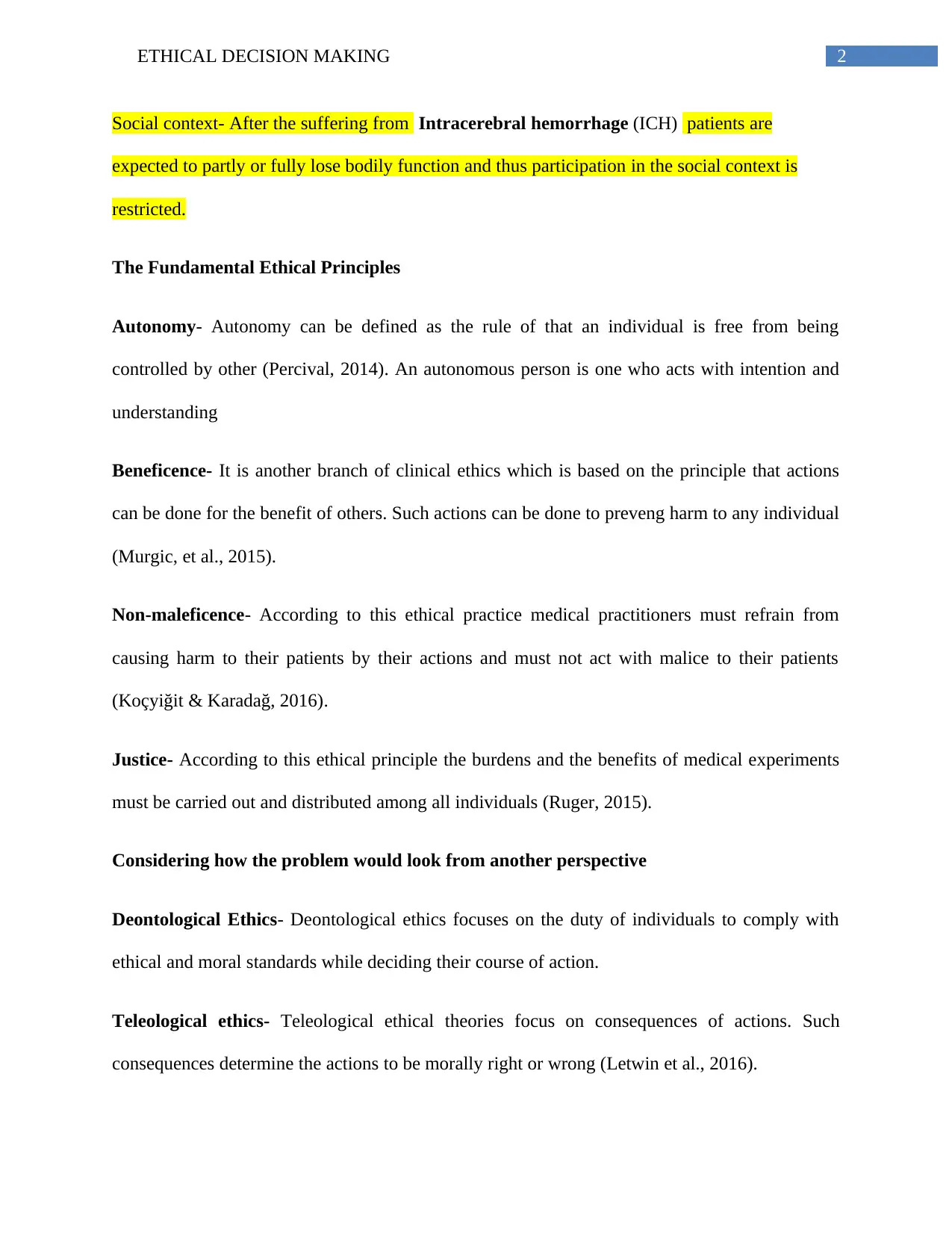
2ETHICAL DECISION MAKING
Social context- After the suffering from Intracerebral hemorrhage (ICH) patients are
expected to partly or fully lose bodily function and thus participation in the social context is
restricted.
The Fundamental Ethical Principles
Autonomy- Autonomy can be defined as the rule of that an individual is free from being
controlled by other (Percival, 2014). An autonomous person is one who acts with intention and
understanding
Beneficence- It is another branch of clinical ethics which is based on the principle that actions
can be done for the benefit of others. Such actions can be done to preveng harm to any individual
(Murgic, et al., 2015).
Non-maleficence- According to this ethical practice medical practitioners must refrain from
causing harm to their patients by their actions and must not act with malice to their patients
(Koçyiğit & Karadağ, 2016).
Justice- According to this ethical principle the burdens and the benefits of medical experiments
must be carried out and distributed among all individuals (Ruger, 2015).
Considering how the problem would look from another perspective
Deontological Ethics- Deontological ethics focuses on the duty of individuals to comply with
ethical and moral standards while deciding their course of action.
Teleological ethics- Teleological ethical theories focus on consequences of actions. Such
consequences determine the actions to be morally right or wrong (Letwin et al., 2016).
Social context- After the suffering from Intracerebral hemorrhage (ICH) patients are
expected to partly or fully lose bodily function and thus participation in the social context is
restricted.
The Fundamental Ethical Principles
Autonomy- Autonomy can be defined as the rule of that an individual is free from being
controlled by other (Percival, 2014). An autonomous person is one who acts with intention and
understanding
Beneficence- It is another branch of clinical ethics which is based on the principle that actions
can be done for the benefit of others. Such actions can be done to preveng harm to any individual
(Murgic, et al., 2015).
Non-maleficence- According to this ethical practice medical practitioners must refrain from
causing harm to their patients by their actions and must not act with malice to their patients
(Koçyiğit & Karadağ, 2016).
Justice- According to this ethical principle the burdens and the benefits of medical experiments
must be carried out and distributed among all individuals (Ruger, 2015).
Considering how the problem would look from another perspective
Deontological Ethics- Deontological ethics focuses on the duty of individuals to comply with
ethical and moral standards while deciding their course of action.
Teleological ethics- Teleological ethical theories focus on consequences of actions. Such
consequences determine the actions to be morally right or wrong (Letwin et al., 2016).
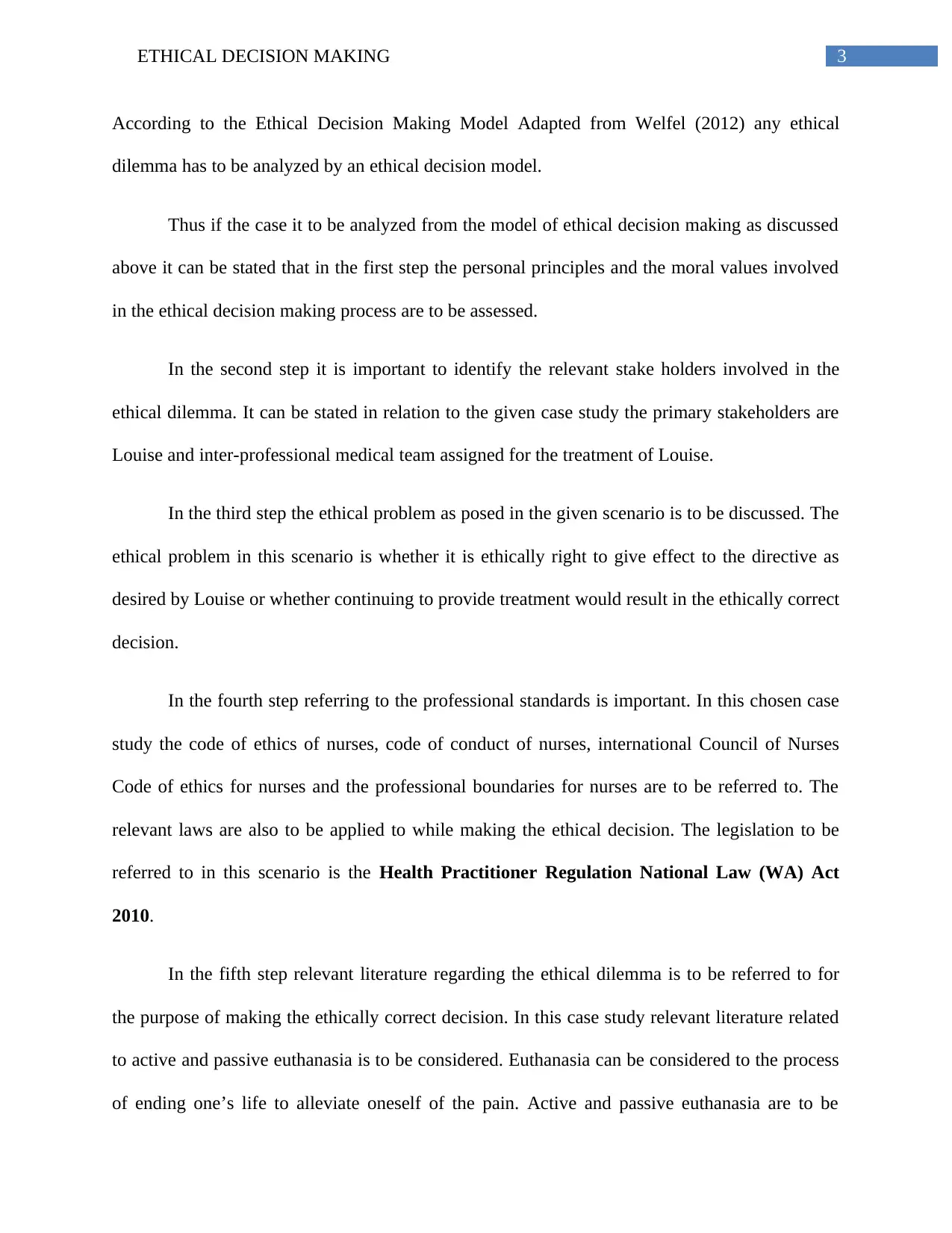
3ETHICAL DECISION MAKING
According to the Ethical Decision Making Model Adapted from Welfel (2012) any ethical
dilemma has to be analyzed by an ethical decision model.
Thus if the case it to be analyzed from the model of ethical decision making as discussed
above it can be stated that in the first step the personal principles and the moral values involved
in the ethical decision making process are to be assessed.
In the second step it is important to identify the relevant stake holders involved in the
ethical dilemma. It can be stated in relation to the given case study the primary stakeholders are
Louise and inter-professional medical team assigned for the treatment of Louise.
In the third step the ethical problem as posed in the given scenario is to be discussed. The
ethical problem in this scenario is whether it is ethically right to give effect to the directive as
desired by Louise or whether continuing to provide treatment would result in the ethically correct
decision.
In the fourth step referring to the professional standards is important. In this chosen case
study the code of ethics of nurses, code of conduct of nurses, international Council of Nurses
Code of ethics for nurses and the professional boundaries for nurses are to be referred to. The
relevant laws are also to be applied to while making the ethical decision. The legislation to be
referred to in this scenario is the Health Practitioner Regulation National Law (WA) Act
2010.
In the fifth step relevant literature regarding the ethical dilemma is to be referred to for
the purpose of making the ethically correct decision. In this case study relevant literature related
to active and passive euthanasia is to be considered. Euthanasia can be considered to the process
of ending one’s life to alleviate oneself of the pain. Active and passive euthanasia are to be
According to the Ethical Decision Making Model Adapted from Welfel (2012) any ethical
dilemma has to be analyzed by an ethical decision model.
Thus if the case it to be analyzed from the model of ethical decision making as discussed
above it can be stated that in the first step the personal principles and the moral values involved
in the ethical decision making process are to be assessed.
In the second step it is important to identify the relevant stake holders involved in the
ethical dilemma. It can be stated in relation to the given case study the primary stakeholders are
Louise and inter-professional medical team assigned for the treatment of Louise.
In the third step the ethical problem as posed in the given scenario is to be discussed. The
ethical problem in this scenario is whether it is ethically right to give effect to the directive as
desired by Louise or whether continuing to provide treatment would result in the ethically correct
decision.
In the fourth step referring to the professional standards is important. In this chosen case
study the code of ethics of nurses, code of conduct of nurses, international Council of Nurses
Code of ethics for nurses and the professional boundaries for nurses are to be referred to. The
relevant laws are also to be applied to while making the ethical decision. The legislation to be
referred to in this scenario is the Health Practitioner Regulation National Law (WA) Act
2010.
In the fifth step relevant literature regarding the ethical dilemma is to be referred to for
the purpose of making the ethically correct decision. In this case study relevant literature related
to active and passive euthanasia is to be considered. Euthanasia can be considered to the process
of ending one’s life to alleviate oneself of the pain. Active and passive euthanasia are to be
Secure Best Marks with AI Grader
Need help grading? Try our AI Grader for instant feedback on your assignments.

4ETHICAL DECISION MAKING
differentiated (Sanders, 2017). While Active Euthanasia is prohibited in Australia, passive
euthanasia is legally permissible. Active Euthanasia can be defined as the process of ending
one’s life by medical intervention while passive Euthanasia can be defined as the withdrawal of
medical support for the purpose of ending one’s life to alleviate oneself from the pain (Emanuel,
2017).
In the Sixth Step of this ethical decision model the ethical dilemma is to be consulted
with relevant colleagues and supervisors. Therefore in the chosen case study the ethical decision
of whether to continue the treatment of the Louise or honor her directive is to be discussed with
the hospital authorities and the family members of Louise as they are to be consulted whether
prior to any plan of action.
In the seventh step a plan of action is to be decided relating to whether to continue her
treatment or withdrawal of medical support. Finally in the eighth step the action plan is to be
communicated to the relevant hospital authorities and the family members of Louise.
Identifying Ethical Conflict- The ethical principles that are in conflict as witnessed in this case
study are Beneficence vs Non-Maleficence and Autonomy vs Beneficence. In this chosen
scenario the ethical conflict that can be identified is whether the Inter professional team in charge
of Louise’s treatment should continue her treatment or withdraw medical support as provided in
her directive.
Considering the law
Legal concepts
differentiated (Sanders, 2017). While Active Euthanasia is prohibited in Australia, passive
euthanasia is legally permissible. Active Euthanasia can be defined as the process of ending
one’s life by medical intervention while passive Euthanasia can be defined as the withdrawal of
medical support for the purpose of ending one’s life to alleviate oneself from the pain (Emanuel,
2017).
In the Sixth Step of this ethical decision model the ethical dilemma is to be consulted
with relevant colleagues and supervisors. Therefore in the chosen case study the ethical decision
of whether to continue the treatment of the Louise or honor her directive is to be discussed with
the hospital authorities and the family members of Louise as they are to be consulted whether
prior to any plan of action.
In the seventh step a plan of action is to be decided relating to whether to continue her
treatment or withdrawal of medical support. Finally in the eighth step the action plan is to be
communicated to the relevant hospital authorities and the family members of Louise.
Identifying Ethical Conflict- The ethical principles that are in conflict as witnessed in this case
study are Beneficence vs Non-Maleficence and Autonomy vs Beneficence. In this chosen
scenario the ethical conflict that can be identified is whether the Inter professional team in charge
of Louise’s treatment should continue her treatment or withdraw medical support as provided in
her directive.
Considering the law
Legal concepts
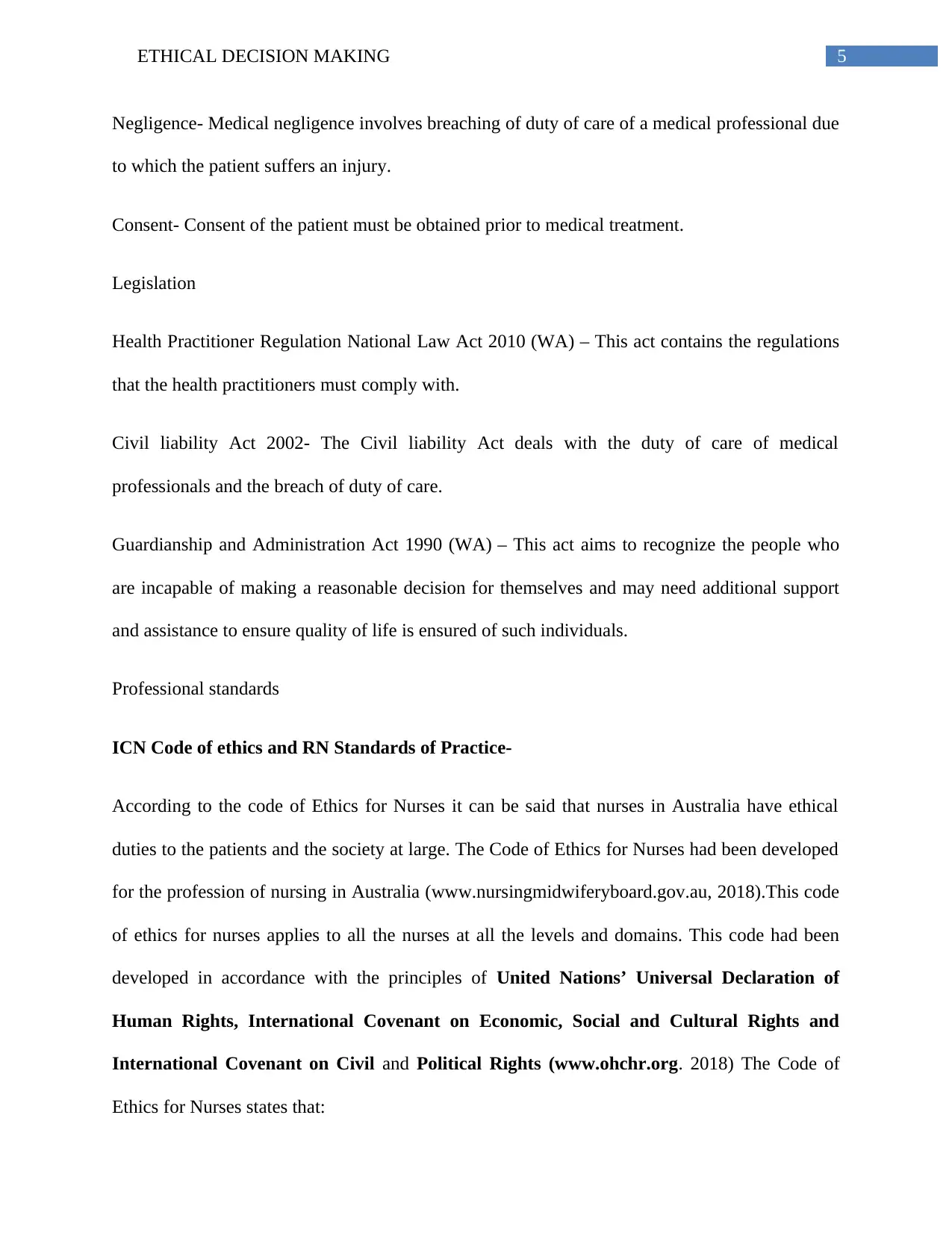
5ETHICAL DECISION MAKING
Negligence- Medical negligence involves breaching of duty of care of a medical professional due
to which the patient suffers an injury.
Consent- Consent of the patient must be obtained prior to medical treatment.
Legislation
Health Practitioner Regulation National Law Act 2010 (WA) – This act contains the regulations
that the health practitioners must comply with.
Civil liability Act 2002- The Civil liability Act deals with the duty of care of medical
professionals and the breach of duty of care.
Guardianship and Administration Act 1990 (WA) – This act aims to recognize the people who
are incapable of making a reasonable decision for themselves and may need additional support
and assistance to ensure quality of life is ensured of such individuals.
Professional standards
ICN Code of ethics and RN Standards of Practice-
According to the code of Ethics for Nurses it can be said that nurses in Australia have ethical
duties to the patients and the society at large. The Code of Ethics for Nurses had been developed
for the profession of nursing in Australia (www.nursingmidwiferyboard.gov.au, 2018).This code
of ethics for nurses applies to all the nurses at all the levels and domains. This code had been
developed in accordance with the principles of United Nations’ Universal Declaration of
Human Rights, International Covenant on Economic, Social and Cultural Rights and
International Covenant on Civil and Political Rights (www.ohchr.org. 2018) The Code of
Ethics for Nurses states that:
Negligence- Medical negligence involves breaching of duty of care of a medical professional due
to which the patient suffers an injury.
Consent- Consent of the patient must be obtained prior to medical treatment.
Legislation
Health Practitioner Regulation National Law Act 2010 (WA) – This act contains the regulations
that the health practitioners must comply with.
Civil liability Act 2002- The Civil liability Act deals with the duty of care of medical
professionals and the breach of duty of care.
Guardianship and Administration Act 1990 (WA) – This act aims to recognize the people who
are incapable of making a reasonable decision for themselves and may need additional support
and assistance to ensure quality of life is ensured of such individuals.
Professional standards
ICN Code of ethics and RN Standards of Practice-
According to the code of Ethics for Nurses it can be said that nurses in Australia have ethical
duties to the patients and the society at large. The Code of Ethics for Nurses had been developed
for the profession of nursing in Australia (www.nursingmidwiferyboard.gov.au, 2018).This code
of ethics for nurses applies to all the nurses at all the levels and domains. This code had been
developed in accordance with the principles of United Nations’ Universal Declaration of
Human Rights, International Covenant on Economic, Social and Cultural Rights and
International Covenant on Civil and Political Rights (www.ohchr.org. 2018) The Code of
Ethics for Nurses states that:
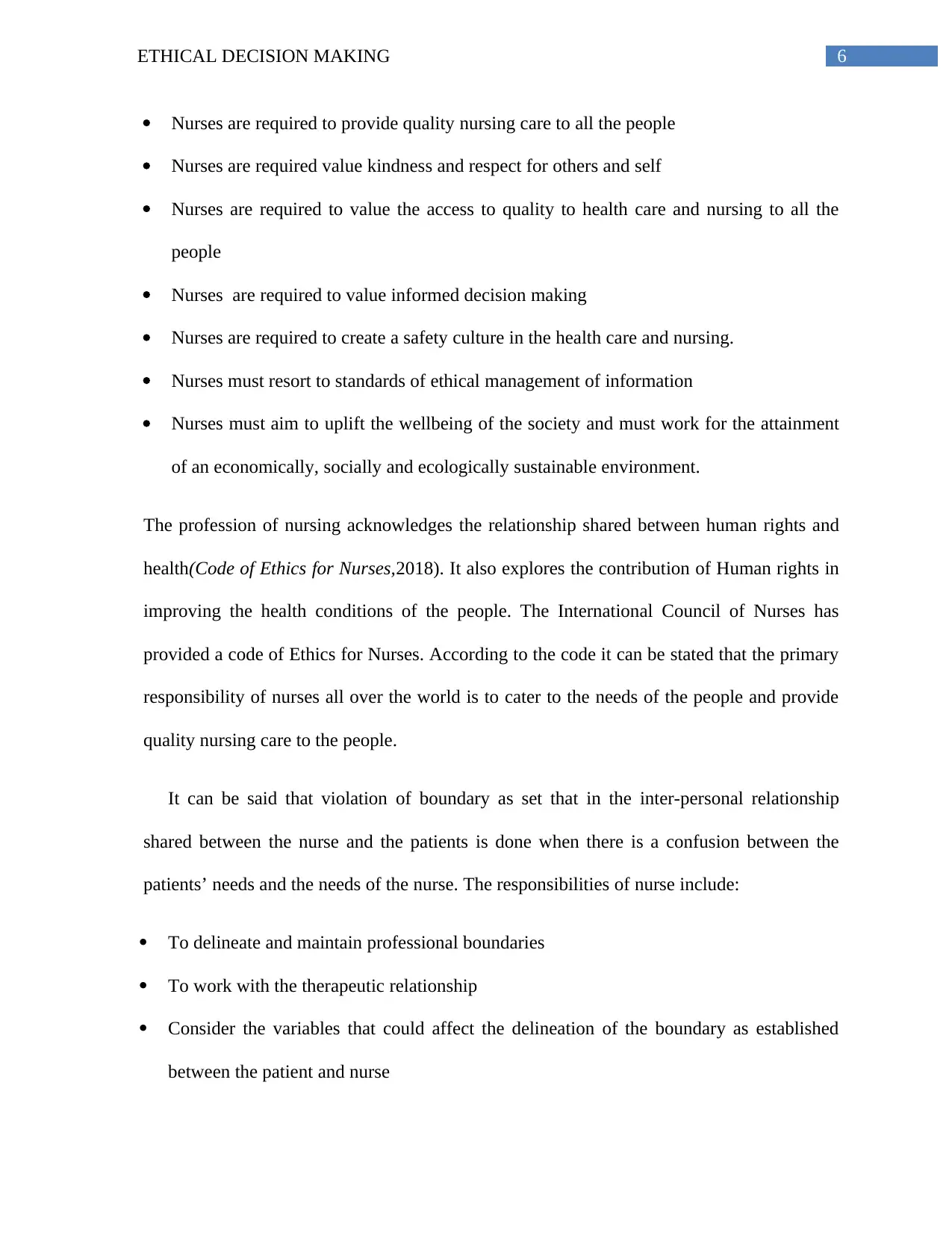
6ETHICAL DECISION MAKING
Nurses are required to provide quality nursing care to all the people
Nurses are required value kindness and respect for others and self
Nurses are required to value the access to quality to health care and nursing to all the
people
Nurses are required to value informed decision making
Nurses are required to create a safety culture in the health care and nursing.
Nurses must resort to standards of ethical management of information
Nurses must aim to uplift the wellbeing of the society and must work for the attainment
of an economically, socially and ecologically sustainable environment.
The profession of nursing acknowledges the relationship shared between human rights and
health(Code of Ethics for Nurses,2018). It also explores the contribution of Human rights in
improving the health conditions of the people. The International Council of Nurses has
provided a code of Ethics for Nurses. According to the code it can be stated that the primary
responsibility of nurses all over the world is to cater to the needs of the people and provide
quality nursing care to the people.
It can be said that violation of boundary as set that in the inter-personal relationship
shared between the nurse and the patients is done when there is a confusion between the
patients’ needs and the needs of the nurse. The responsibilities of nurse include:
To delineate and maintain professional boundaries
To work with the therapeutic relationship
Consider the variables that could affect the delineation of the boundary as established
between the patient and nurse
Nurses are required to provide quality nursing care to all the people
Nurses are required value kindness and respect for others and self
Nurses are required to value the access to quality to health care and nursing to all the
people
Nurses are required to value informed decision making
Nurses are required to create a safety culture in the health care and nursing.
Nurses must resort to standards of ethical management of information
Nurses must aim to uplift the wellbeing of the society and must work for the attainment
of an economically, socially and ecologically sustainable environment.
The profession of nursing acknowledges the relationship shared between human rights and
health(Code of Ethics for Nurses,2018). It also explores the contribution of Human rights in
improving the health conditions of the people. The International Council of Nurses has
provided a code of Ethics for Nurses. According to the code it can be stated that the primary
responsibility of nurses all over the world is to cater to the needs of the people and provide
quality nursing care to the people.
It can be said that violation of boundary as set that in the inter-personal relationship
shared between the nurse and the patients is done when there is a confusion between the
patients’ needs and the needs of the nurse. The responsibilities of nurse include:
To delineate and maintain professional boundaries
To work with the therapeutic relationship
Consider the variables that could affect the delineation of the boundary as established
between the patient and nurse
Paraphrase This Document
Need a fresh take? Get an instant paraphrase of this document with our AI Paraphraser
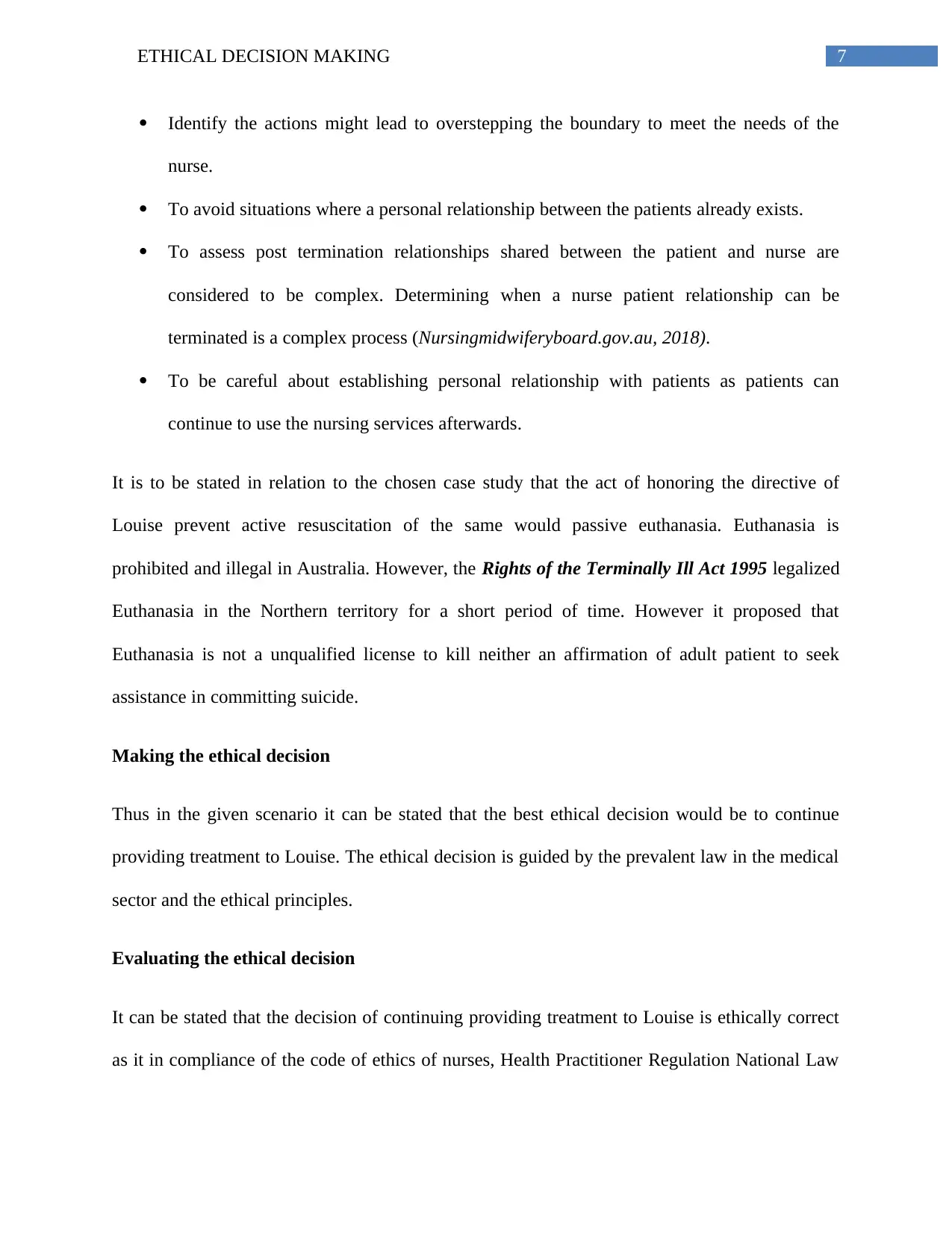
7ETHICAL DECISION MAKING
Identify the actions might lead to overstepping the boundary to meet the needs of the
nurse.
To avoid situations where a personal relationship between the patients already exists.
To assess post termination relationships shared between the patient and nurse are
considered to be complex. Determining when a nurse patient relationship can be
terminated is a complex process (Nursingmidwiferyboard.gov.au, 2018).
To be careful about establishing personal relationship with patients as patients can
continue to use the nursing services afterwards.
It is to be stated in relation to the chosen case study that the act of honoring the directive of
Louise prevent active resuscitation of the same would passive euthanasia. Euthanasia is
prohibited and illegal in Australia. However, the Rights of the Terminally Ill Act 1995 legalized
Euthanasia in the Northern territory for a short period of time. However it proposed that
Euthanasia is not a unqualified license to kill neither an affirmation of adult patient to seek
assistance in committing suicide.
Making the ethical decision
Thus in the given scenario it can be stated that the best ethical decision would be to continue
providing treatment to Louise. The ethical decision is guided by the prevalent law in the medical
sector and the ethical principles.
Evaluating the ethical decision
It can be stated that the decision of continuing providing treatment to Louise is ethically correct
as it in compliance of the code of ethics of nurses, Health Practitioner Regulation National Law
Identify the actions might lead to overstepping the boundary to meet the needs of the
nurse.
To avoid situations where a personal relationship between the patients already exists.
To assess post termination relationships shared between the patient and nurse are
considered to be complex. Determining when a nurse patient relationship can be
terminated is a complex process (Nursingmidwiferyboard.gov.au, 2018).
To be careful about establishing personal relationship with patients as patients can
continue to use the nursing services afterwards.
It is to be stated in relation to the chosen case study that the act of honoring the directive of
Louise prevent active resuscitation of the same would passive euthanasia. Euthanasia is
prohibited and illegal in Australia. However, the Rights of the Terminally Ill Act 1995 legalized
Euthanasia in the Northern territory for a short period of time. However it proposed that
Euthanasia is not a unqualified license to kill neither an affirmation of adult patient to seek
assistance in committing suicide.
Making the ethical decision
Thus in the given scenario it can be stated that the best ethical decision would be to continue
providing treatment to Louise. The ethical decision is guided by the prevalent law in the medical
sector and the ethical principles.
Evaluating the ethical decision
It can be stated that the decision of continuing providing treatment to Louise is ethically correct
as it in compliance of the code of ethics of nurses, Health Practitioner Regulation National Law
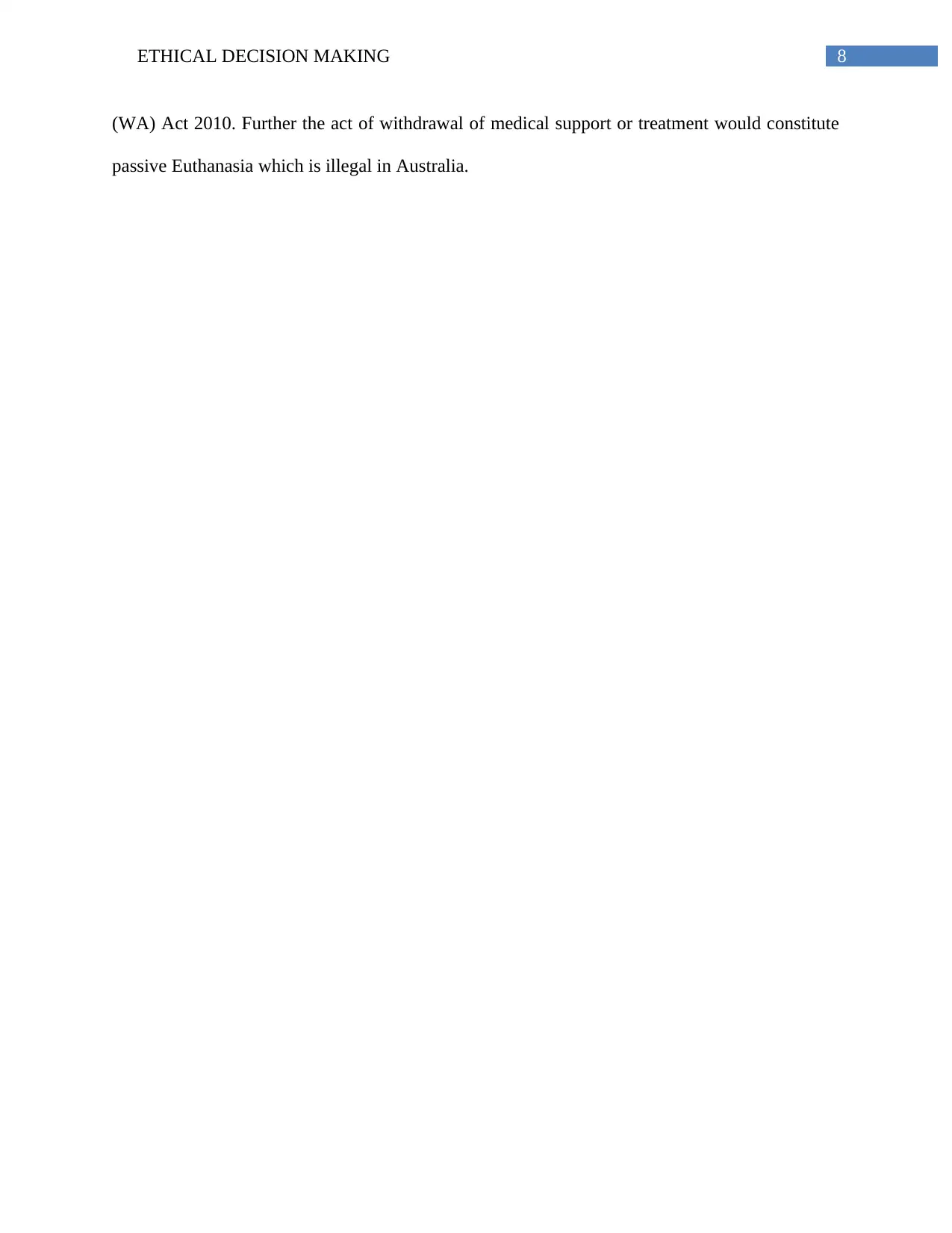
8ETHICAL DECISION MAKING
(WA) Act 2010. Further the act of withdrawal of medical support or treatment would constitute
passive Euthanasia which is illegal in Australia.
(WA) Act 2010. Further the act of withdrawal of medical support or treatment would constitute
passive Euthanasia which is illegal in Australia.
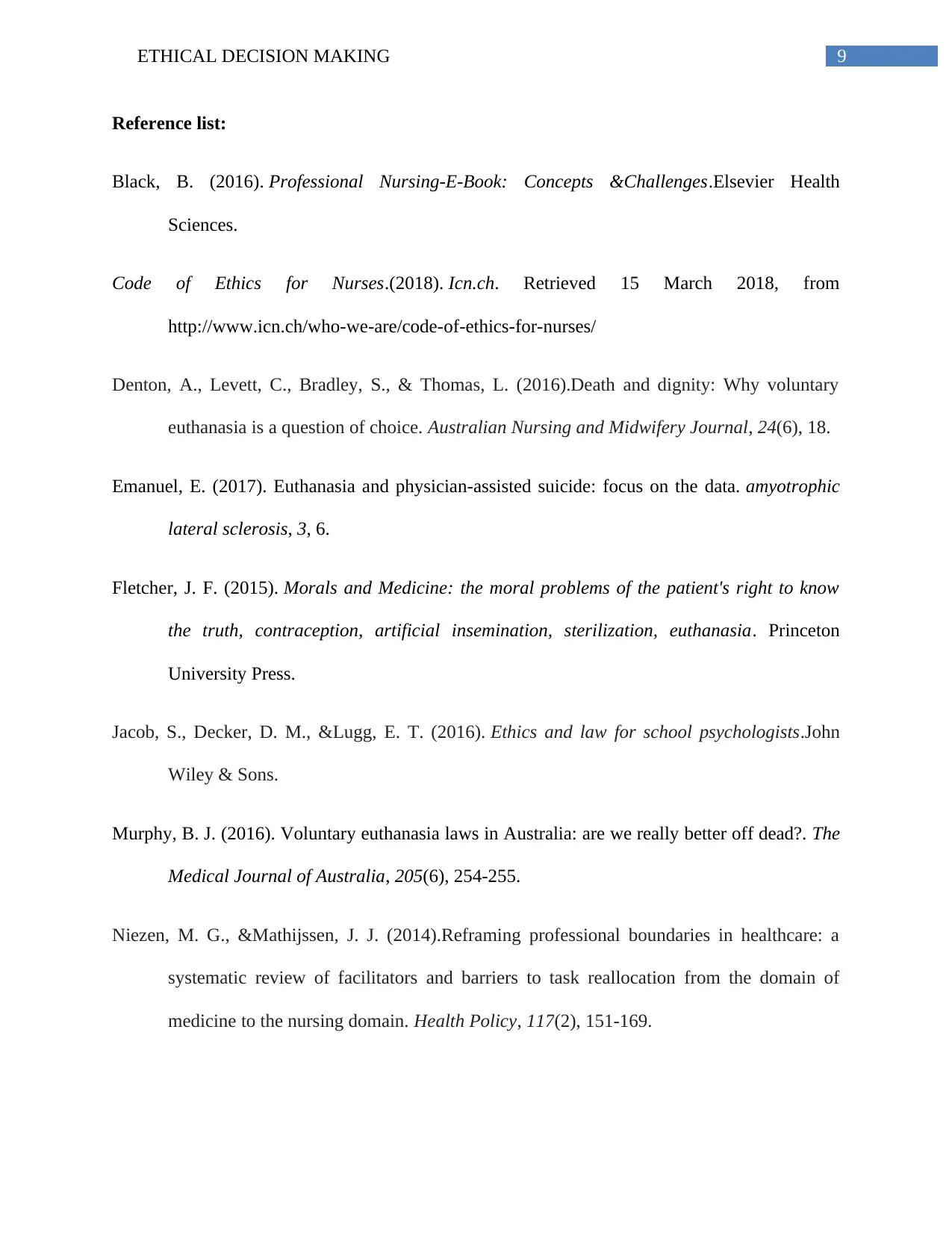
9ETHICAL DECISION MAKING
Reference list:
Black, B. (2016). Professional Nursing-E-Book: Concepts &Challenges.Elsevier Health
Sciences.
Code of Ethics for Nurses.(2018). Icn.ch. Retrieved 15 March 2018, from
http://www.icn.ch/who-we-are/code-of-ethics-for-nurses/
Denton, A., Levett, C., Bradley, S., & Thomas, L. (2016).Death and dignity: Why voluntary
euthanasia is a question of choice. Australian Nursing and Midwifery Journal, 24(6), 18.
Emanuel, E. (2017). Euthanasia and physician-assisted suicide: focus on the data. amyotrophic
lateral sclerosis, 3, 6.
Fletcher, J. F. (2015). Morals and Medicine: the moral problems of the patient's right to know
the truth, contraception, artificial insemination, sterilization, euthanasia. Princeton
University Press.
Jacob, S., Decker, D. M., &Lugg, E. T. (2016). Ethics and law for school psychologists.John
Wiley & Sons.
Murphy, B. J. (2016). Voluntary euthanasia laws in Australia: are we really better off dead?. The
Medical Journal of Australia, 205(6), 254-255.
Niezen, M. G., &Mathijssen, J. J. (2014).Reframing professional boundaries in healthcare: a
systematic review of facilitators and barriers to task reallocation from the domain of
medicine to the nursing domain. Health Policy, 117(2), 151-169.
Reference list:
Black, B. (2016). Professional Nursing-E-Book: Concepts &Challenges.Elsevier Health
Sciences.
Code of Ethics for Nurses.(2018). Icn.ch. Retrieved 15 March 2018, from
http://www.icn.ch/who-we-are/code-of-ethics-for-nurses/
Denton, A., Levett, C., Bradley, S., & Thomas, L. (2016).Death and dignity: Why voluntary
euthanasia is a question of choice. Australian Nursing and Midwifery Journal, 24(6), 18.
Emanuel, E. (2017). Euthanasia and physician-assisted suicide: focus on the data. amyotrophic
lateral sclerosis, 3, 6.
Fletcher, J. F. (2015). Morals and Medicine: the moral problems of the patient's right to know
the truth, contraception, artificial insemination, sterilization, euthanasia. Princeton
University Press.
Jacob, S., Decker, D. M., &Lugg, E. T. (2016). Ethics and law for school psychologists.John
Wiley & Sons.
Murphy, B. J. (2016). Voluntary euthanasia laws in Australia: are we really better off dead?. The
Medical Journal of Australia, 205(6), 254-255.
Niezen, M. G., &Mathijssen, J. J. (2014).Reframing professional boundaries in healthcare: a
systematic review of facilitators and barriers to task reallocation from the domain of
medicine to the nursing domain. Health Policy, 117(2), 151-169.
Secure Best Marks with AI Grader
Need help grading? Try our AI Grader for instant feedback on your assignments.
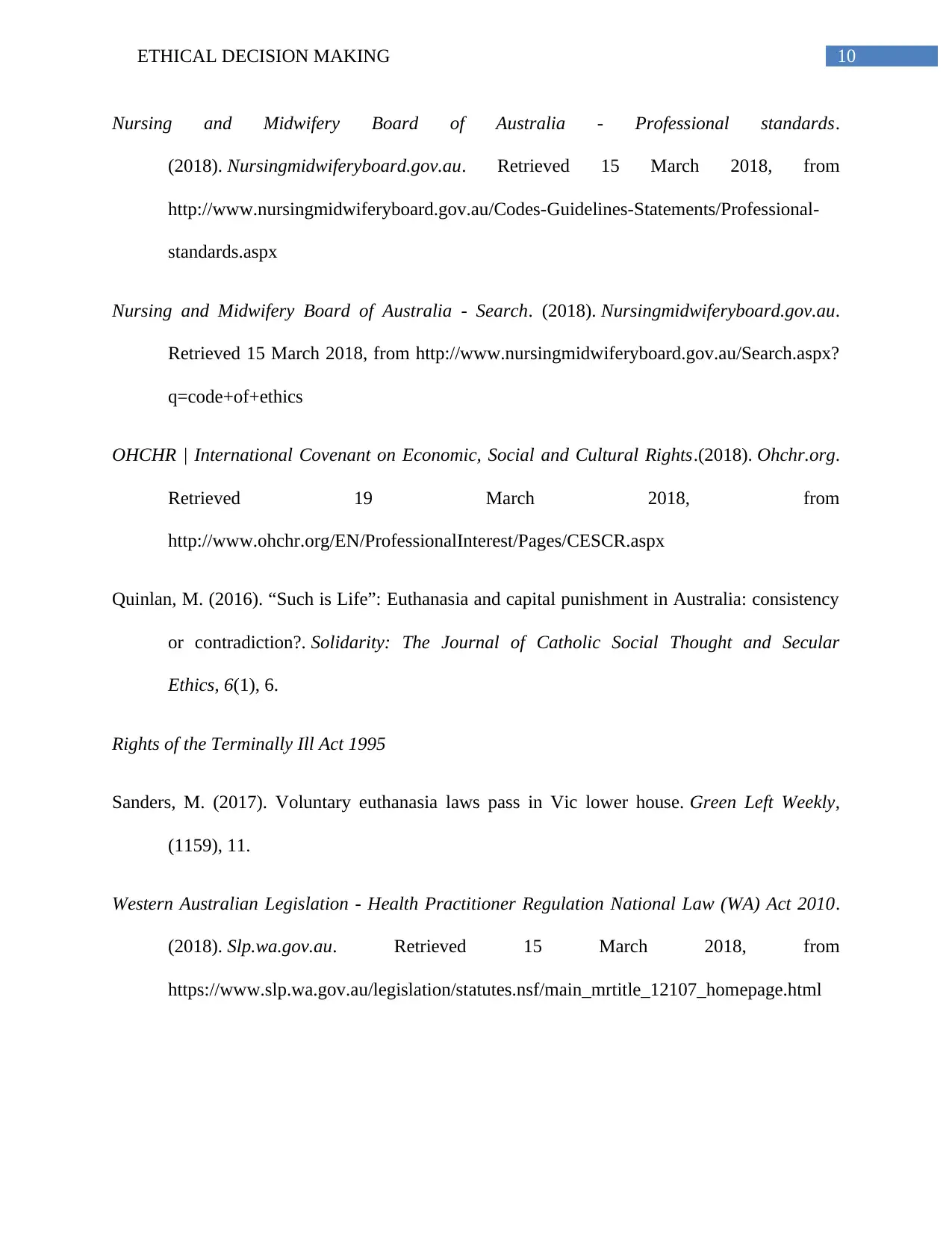
10ETHICAL DECISION MAKING
Nursing and Midwifery Board of Australia - Professional standards.
(2018). Nursingmidwiferyboard.gov.au. Retrieved 15 March 2018, from
http://www.nursingmidwiferyboard.gov.au/Codes-Guidelines-Statements/Professional-
standards.aspx
Nursing and Midwifery Board of Australia - Search. (2018). Nursingmidwiferyboard.gov.au.
Retrieved 15 March 2018, from http://www.nursingmidwiferyboard.gov.au/Search.aspx?
q=code+of+ethics
OHCHR | International Covenant on Economic, Social and Cultural Rights.(2018). Ohchr.org.
Retrieved 19 March 2018, from
http://www.ohchr.org/EN/ProfessionalInterest/Pages/CESCR.aspx
Quinlan, M. (2016). “Such is Life”: Euthanasia and capital punishment in Australia: consistency
or contradiction?. Solidarity: The Journal of Catholic Social Thought and Secular
Ethics, 6(1), 6.
Rights of the Terminally Ill Act 1995
Sanders, M. (2017). Voluntary euthanasia laws pass in Vic lower house. Green Left Weekly,
(1159), 11.
Western Australian Legislation - Health Practitioner Regulation National Law (WA) Act 2010.
(2018). Slp.wa.gov.au. Retrieved 15 March 2018, from
https://www.slp.wa.gov.au/legislation/statutes.nsf/main_mrtitle_12107_homepage.html
Nursing and Midwifery Board of Australia - Professional standards.
(2018). Nursingmidwiferyboard.gov.au. Retrieved 15 March 2018, from
http://www.nursingmidwiferyboard.gov.au/Codes-Guidelines-Statements/Professional-
standards.aspx
Nursing and Midwifery Board of Australia - Search. (2018). Nursingmidwiferyboard.gov.au.
Retrieved 15 March 2018, from http://www.nursingmidwiferyboard.gov.au/Search.aspx?
q=code+of+ethics
OHCHR | International Covenant on Economic, Social and Cultural Rights.(2018). Ohchr.org.
Retrieved 19 March 2018, from
http://www.ohchr.org/EN/ProfessionalInterest/Pages/CESCR.aspx
Quinlan, M. (2016). “Such is Life”: Euthanasia and capital punishment in Australia: consistency
or contradiction?. Solidarity: The Journal of Catholic Social Thought and Secular
Ethics, 6(1), 6.
Rights of the Terminally Ill Act 1995
Sanders, M. (2017). Voluntary euthanasia laws pass in Vic lower house. Green Left Weekly,
(1159), 11.
Western Australian Legislation - Health Practitioner Regulation National Law (WA) Act 2010.
(2018). Slp.wa.gov.au. Retrieved 15 March 2018, from
https://www.slp.wa.gov.au/legislation/statutes.nsf/main_mrtitle_12107_homepage.html
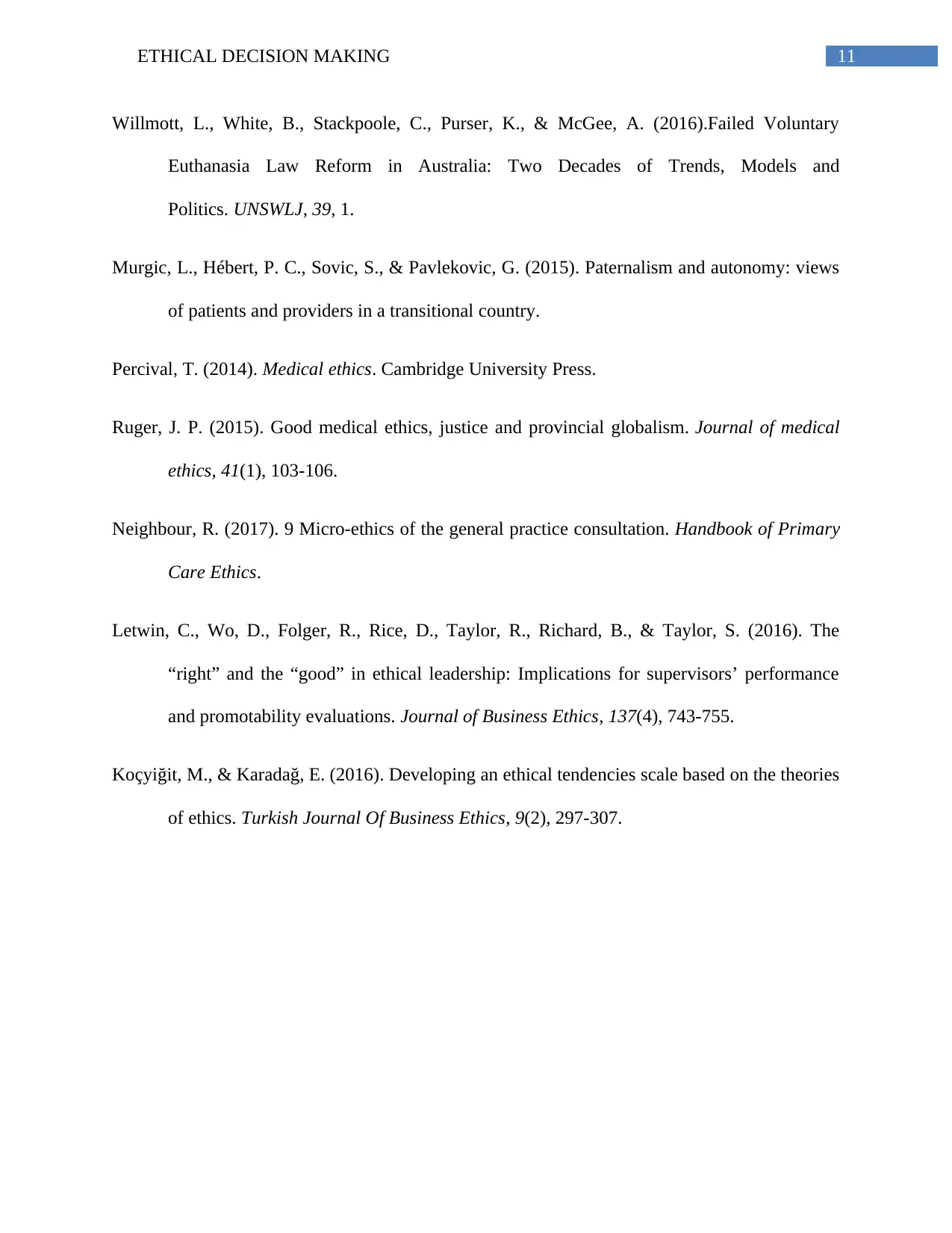
11ETHICAL DECISION MAKING
Willmott, L., White, B., Stackpoole, C., Purser, K., & McGee, A. (2016).Failed Voluntary
Euthanasia Law Reform in Australia: Two Decades of Trends, Models and
Politics. UNSWLJ, 39, 1.
Murgic, L., Hébert, P. C., Sovic, S., & Pavlekovic, G. (2015). Paternalism and autonomy: views
of patients and providers in a transitional country.
Percival, T. (2014). Medical ethics. Cambridge University Press.
Ruger, J. P. (2015). Good medical ethics, justice and provincial globalism. Journal of medical
ethics, 41(1), 103-106.
Neighbour, R. (2017). 9 Micro-ethics of the general practice consultation. Handbook of Primary
Care Ethics.
Letwin, C., Wo, D., Folger, R., Rice, D., Taylor, R., Richard, B., & Taylor, S. (2016). The
“right” and the “good” in ethical leadership: Implications for supervisors’ performance
and promotability evaluations. Journal of Business Ethics, 137(4), 743-755.
Koçyiğit, M., & Karadağ, E. (2016). Developing an ethical tendencies scale based on the theories
of ethics. Turkish Journal Of Business Ethics, 9(2), 297-307.
Willmott, L., White, B., Stackpoole, C., Purser, K., & McGee, A. (2016).Failed Voluntary
Euthanasia Law Reform in Australia: Two Decades of Trends, Models and
Politics. UNSWLJ, 39, 1.
Murgic, L., Hébert, P. C., Sovic, S., & Pavlekovic, G. (2015). Paternalism and autonomy: views
of patients and providers in a transitional country.
Percival, T. (2014). Medical ethics. Cambridge University Press.
Ruger, J. P. (2015). Good medical ethics, justice and provincial globalism. Journal of medical
ethics, 41(1), 103-106.
Neighbour, R. (2017). 9 Micro-ethics of the general practice consultation. Handbook of Primary
Care Ethics.
Letwin, C., Wo, D., Folger, R., Rice, D., Taylor, R., Richard, B., & Taylor, S. (2016). The
“right” and the “good” in ethical leadership: Implications for supervisors’ performance
and promotability evaluations. Journal of Business Ethics, 137(4), 743-755.
Koçyiğit, M., & Karadağ, E. (2016). Developing an ethical tendencies scale based on the theories
of ethics. Turkish Journal Of Business Ethics, 9(2), 297-307.
1 out of 12
Related Documents
Your All-in-One AI-Powered Toolkit for Academic Success.
+13062052269
info@desklib.com
Available 24*7 on WhatsApp / Email
![[object Object]](/_next/static/media/star-bottom.7253800d.svg)
Unlock your academic potential
© 2024 | Zucol Services PVT LTD | All rights reserved.





